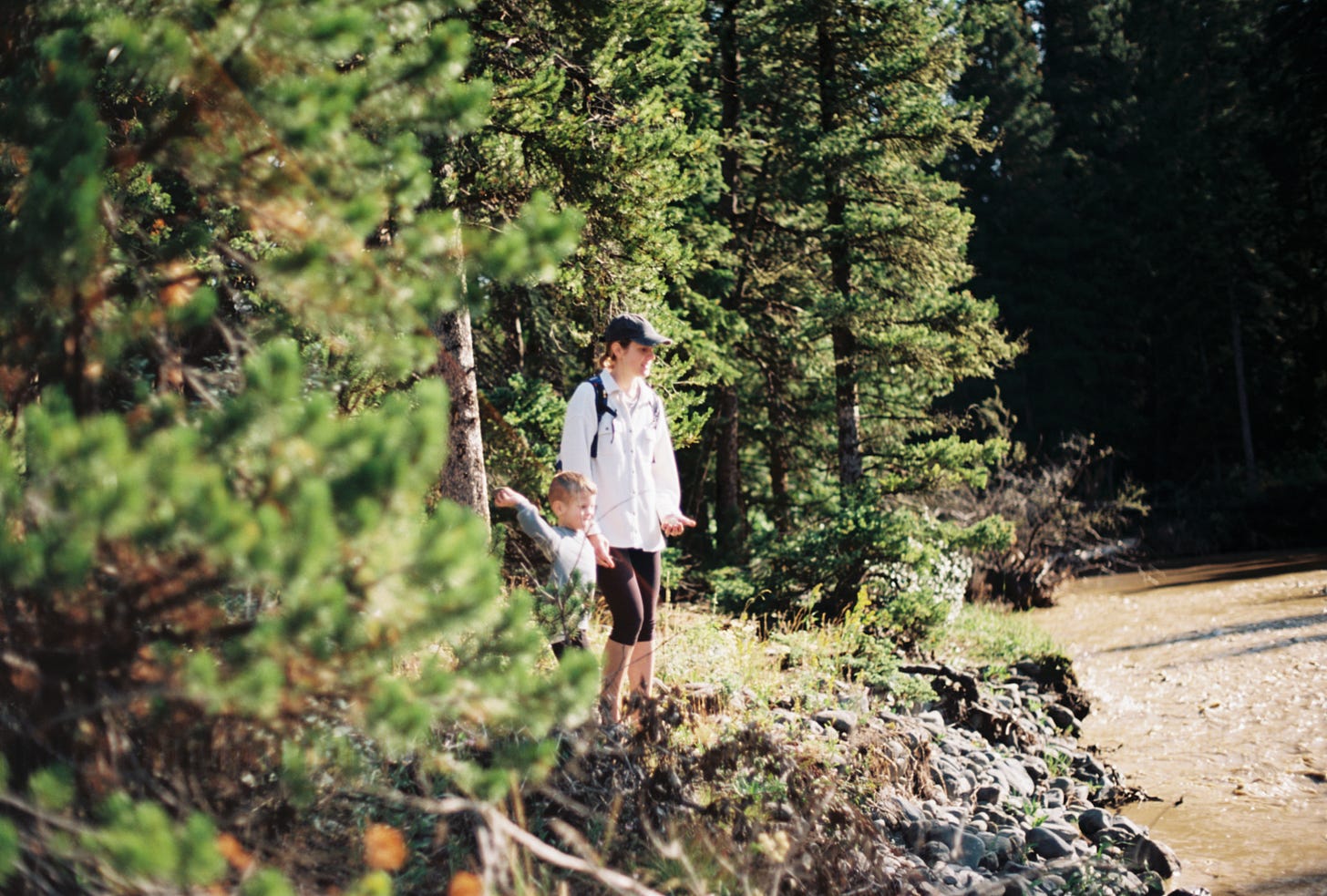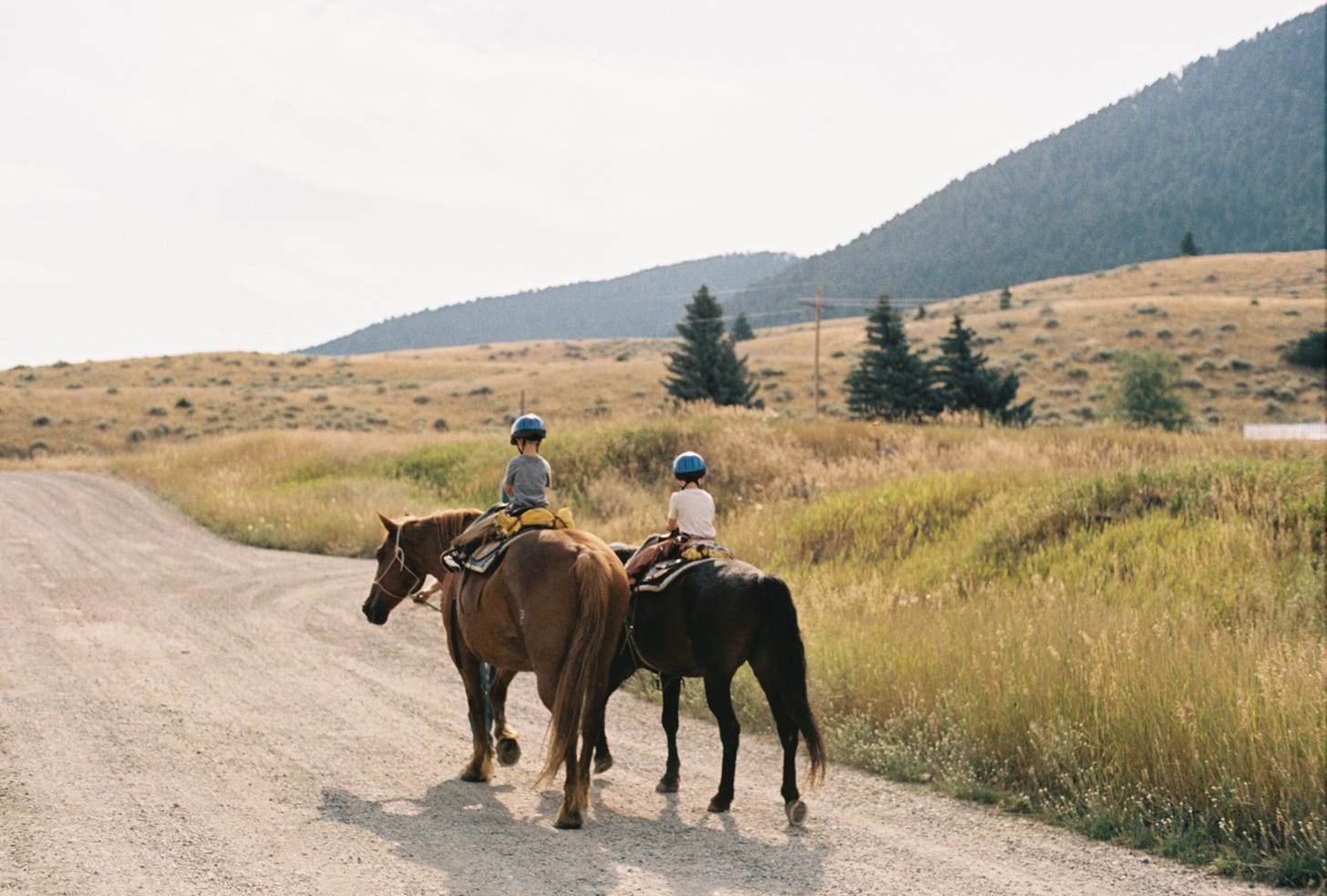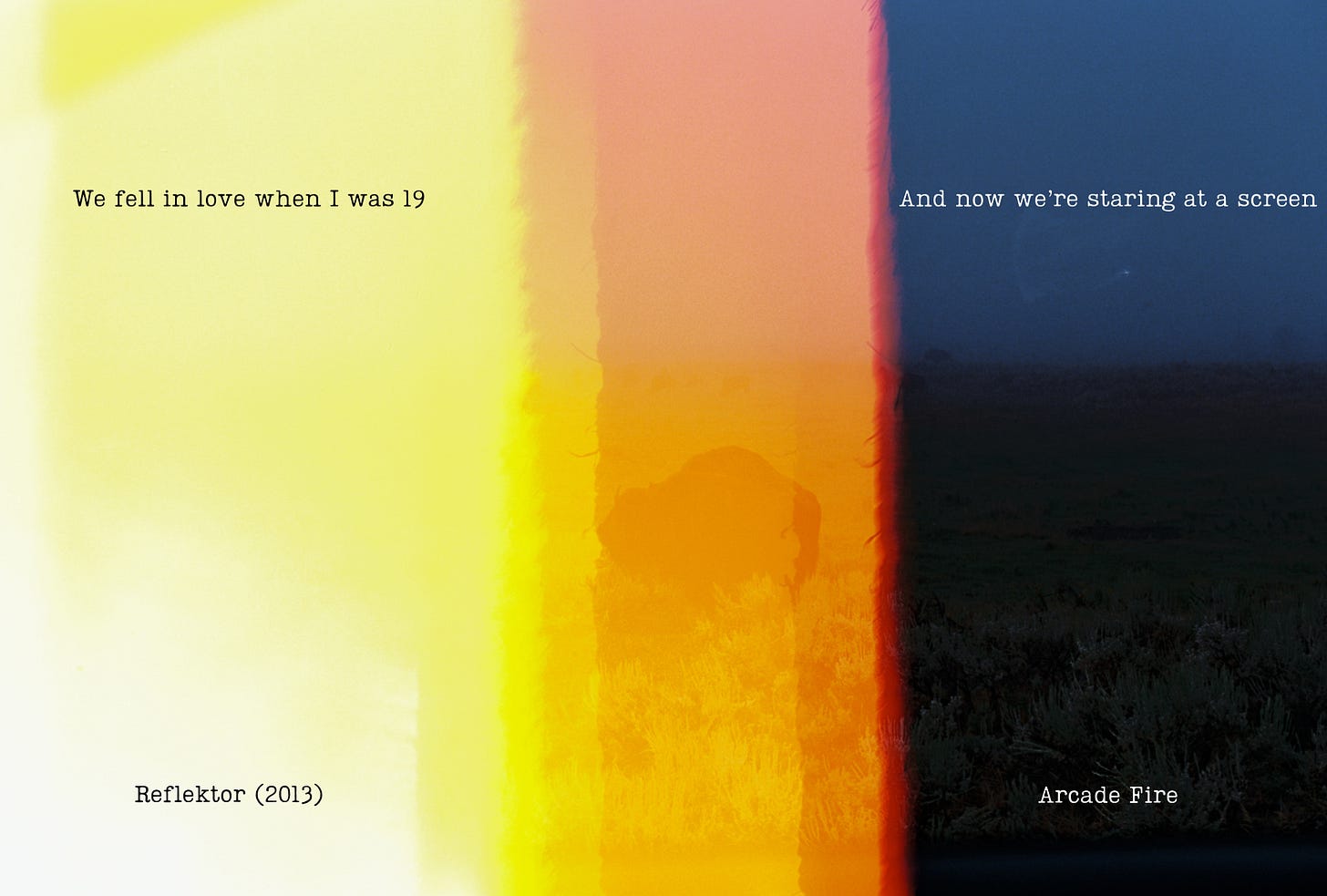Get Out
Going outside is the solution to most of our problems
My baby ate mud from a freezing cold river last week. It was the happiest he’s ever been.
It was the happiest I’ve ever been as a dad, too. Because it was the perfect example of something I’ve been feeling strongly as a parent, and as a human being lately: there’s nothing better than being outside.
My wife and I have spent 11 of the last 40 days in the mountains, first in Breckenridge, CO and then in Paradise Valley, MT. We’re going to Chattanooga, TN in a couple of weeks to round out our summer in the mountains. It’s been refreshing and exhilarating. Being outside non-stop in the summer without dying of heat exhaustion is impossible to top.
Seeing our two young boys thriving in the frigid Yellowstone River was the perfect example of our parenting philosophy: the outdoors are better than any manmade toy, device, or game designed to entertain children. Our four-year-old son, Carter, told us that playing in the river was “the best playtime I’ve ever had in my life.” He’s very prone to exaggeration like all little kids, but he truly meant it and has reiterated it over and over again. We brought no toys, taught him no games, and set no rules. He came up with everything he did and he would have stayed out there all day if we let him. Malcolm, our 13 month old, was so thrilled to have the freedom to crawl along the river bed, get waist deep in water, throw rocks, and, yes, taste the local river mud.
Perhaps the best part for us as parents: that night they went to sleep right on time. They were exhausted in the best way possible.
There’s never been a better time in history to be a toymaker for kids. There’s an insatiable desire from parents to find something to entertain their little ones. Parents are also intent on finding toys that develop their child’s brains and bodies in the best way possible. They want toys that are designed for the exact stage their child is in so that they have a kid who is developing at the exact right pace.
Yet research is constantly proving that nothing invented by humans stimulates and develops kids’ brains as effectively as the outdoors.
Make Every Minute Count
The best designers create a picture of something you had in your mind that you could never have translated to real life. The best communicators give voice to something that you know and feel inherently, but never had the vocabulary or framework to explain those feelings.
For my wife and I, that has been Ginny Yurich and her 1000 Hours Outside program. I instantly connected with her ideas just from hearing the title a few years ago. I knew that I was going to resonate with what she had to say before I even read anything.
To quickly sum up her philosophy: children should be spending a majority of their day outside in unstructured, free play time. Her program sets the goal of 1000 hours per year outside, which equals out to about 3 hours per day for the entire year. Of course, calculating for extreme weather, busyness, and other factors, you’re actually looking at much more than 3 hours per day on the days that you can get out there.
While that may sound like a lot, kids 8-12 spend up to 2000 hours on screens per year, while teenagers spend more than 3000 hours. So yes, there is time in the day for outdoor play, it just must come out of the time being wasted on screens.
Essentially what it ends up being is spending as much free time as you possibly can outside, in every season, and in every non-extreme weather pattern. We have tried to reach this goal before and started off strong in the Winter and Spring, got derailed as the extreme heat of the Summer kicked in, and then tried to resurrect it in the Fall and Winter. We probably ended up with 400-500 hours in that year. But that’s the beauty of the 1000 hours goal, even if you don’t reach 1000 hours for the year you still got hundreds of extra hours outside that you might not have if you didn’t prioritize it. And in those hours you and your kids experienced so many amazing benefits.
It would be nearly impossible to list all of the benefits of playing outside for kids, and researchers are finding more benefits every day, but some of the biggest benefits are improved bone development, immunity, and sleep from the sun’s vitamin D, the development of executive functioning and self-regulation skills that are crucial to success as an adult, and learning how to take risks and bounce back from failing in these risks.
Outdoor play also develops all of your senses as you take in the sights, smells, sounds, feelings, and, yes, tastes of the trees, dirts, leaves, rain, creeks, and animals. Everything a child needs to grow and develop can be found in abundance outdoors. Even the basics of math and science are easily taught using elements in nature.
Unstructured outdoor play allows kids to develop soft skills as well, from creating games by themselves or with friends to navigating complicated social situations when someone feels left out or frustrated by the specific game being played.
It would be strange to have to explain the benefits of children playing freely outdoors to pretty much any generation born before 1960. Outside was basically the only fun place for kids for thousands of years. Kids weren’t having to be coerced to go outside, they were heading out there the second they could and not coming home until, as the title of Ginny’s book says, “the streetlights came on.”
This was, for the entire existence of humans until around the 1980s, the “play-based childhood.” No one had to fight for their kids to experience a play-based, outdoor childhood because that’s all that existed. It’s how children were designed to develop.
Now, parents in our generation are having to contend with something that threatens to hijack and derail our children’s lives: the “screen-based childhood.”

The Most Important Book of the 21st Century
“Play-based childhood” and “screen-based childhood” are terms I’ve taken from Jonathan Haidt’s world-changing, groundbreaking book The Anxious Generation which I read at the end of July.
Ginny’s 1000 Hours Outside program opened my eyes to the importance of prioritizing outdoors in a positive, winsome way. Haidt’s book, on the other hand, is a terrifying call to action for parents, government, and school administrators about the absolute devastation caused by smartphones, social media, and video games on Gen Z and the threats it holds for all subsequent generations if we don’t do something as a society to stop it.
I am telling you all right now, this is the the most important book of the 21st century. It was published in March of this year and it’s already leading the way in changing federal law, spearheading the Phone Free Schools movement, and causing parents across the country to take their kids’ childhoods back from the big tech companies who prey on their vulnerable children.
Haidt uses exhaustive research to prove over and over again that the “Great Rewiring of Childhood,” as he calls it, from the play-based childhood to the phone-based (or screen-based) childhood has massive impacts on the development of children’s brains. And when he’s talking about children he’s talking about kids all the way up to 18 years old. It’s not just keeping iPads out of your 6-year-old’s hands, it’s keeping smartphones and tablets and any form of social media away from your kids until they are well into their teen years. He explores the ways that social media companies entice young teens to create accounts and then bombard them with harmful content until they no longer recognize themselves or feel like they can live without their Instagram or TikTok. Many teens spend more than eight hours per day on their phones and almost zero minutes outside. Even when they aren’t on their phones, they are thinking about what’s going on in the virtual world and whether they’re missing out on something.
The harm done to Gen Z is apparent to anyone who knows someone in this generation. They are by far the most anxious, depressed, “lost” generation in history. Haidt even delves into counter-arguments against these facts, such as those who say that Gen Z simply knows more about mental health so they are more likely to express feelings of anxiety or depression in a survey. To summarize what he explains in detail: if these were just reports based on mental health awareness, then actual actions taken based on these mental health challenges wouldn’t reflect these inflated numbers. But, extremely sadly, actions taken, like suicide attempts, follow along closely with these trends.
It’s not that the screen-based childhood has just made kids more aware of mental health challenges. The data very clearly shows that the screen-based childhood is directly causing mental health challenges.
The play-based childhood as a whole ended with the advent of smartphones and social media in the early 2010s, but Haidt actually traces its decline back to the early 1980s. He examines several different factors and settles on the overarching theme of “safetyism” that led to the gradually decline of the outdoors-based free playing childhood. Every millenial has heard stories from their parents and grandparents, and even from most in Gen X, about the absolute freedom they had as 8 year olds to ride a bike around town with friends. They chuckle about how irresponsible it was for their parents to let them leave the house with absolutely no way to reach them until they came home for a meal. In fact, allowing their children freedom to explore outdoors and learn responsibility at a young age was the most responsible thing their parents could have done.
But Haidt shows that the advent of the 1980s created several factors that caused parents to bring their kids much closer to home, eventually leading to the attitude of the 2010s where many parents felt it was safer to have a kid at home watching TikTok videos instead of being at an unknown outdoor location with friends. Some factors, like fear of a child being kidnapped, were borne out of a legitimate, though unlikely, scenario. Parents in the 1950s never really considered that it could happen to their kid. Yet, for some, it became a horrible reality. As media began covering these stories more, by the 1980s every parent was terrified it would happen to their child. So free rein to ride a bike to a park miles away became less and less common. Other factors increased safetyism that limited childhood freedom that Haidt delves into in detail, like fear of litigation if a child got hurt on a jungle gym.
For many parents, the idea of letting a kid do anything on their own that might lead to them getting hurt, physically, mentally, or emotionally was so terrifying that they ended up raising the least resilient, least experience-rich generation ever. Instead of letting a kid climb a tree and risk falling and breaking his arm, they gave a kid an iPad to stay safely inside, unknowingly risking breaking far more than an arm.
Outside is the Answer
The solution, as Haidt proposes, Yurich promotes, and many, many, many other experts and studies confirm is simple:
Go Outside.
Take away the screens. Sell the Playstation. Delete the social media.
As a Christian, which Yurich also is, the answer seems so obvious. God created us to be outside. The first scenes in the Bible are in the idyllic Garden of Eden. When He created the perfect paradise for mankind to dwell, He didn’t build them a fancy palace, He had them live in a lush, beautiful garden surrounded by wild animals. He placed a desire in the heart of man to be among His creation. So much of scripture declares the majesty and beauty of creation, from the pastoral beauty of the Psalms to scenes of Jesus stealing away to the hills to be alone with God. He emphasizes over and over again that His creation is there for us to enjoy, to benefit from, to protect and steward, and to find rest in.
Haidt is an atheist and an academic. He has great appreciation for spiritual practices and in The Anxious Generation spends a significant amount of time discussing the benefits of spiritual practices, community focus, and believing in a greater purpose than oneself. He quotes scriptures more than some pastors do. But, at the end of the day, he needs scientific backing for all of his claims. He shows that it’s exceedingly clear that our brains, especially children’s brains, were created (or in his view, evolved) to grow from free play outdoors. The outdoors provide a never-ending list of values for children and their brains.
Screens, in contrast, provide none.
Opting Outside
This is becoming my wife and I’s guiding light as we parent our children. We are not only doubling down on our commitment to not allow our children to have any kind of handheld screen device until they are 16, but also recommitting to the ideals that Yurich espouses of raising our kids outdoors. It also means examining the ways that we are creating bad beliefs and habits for our kids.
Are we spending too much time on our own phones while our kids watch us?
Are we orienting our own lives to be outdoors as much as we can?
Are we allowing our fully-formed adult brains to be hacked by big tech companies promising us a little hit of dopamine if we just open Instagram one more time?
These are extremely challenging questions to work through. How can we live in a world that has become so intertwined with social media without becoming enslaved to it ourselves? There are so many positive elements involved with social media, and some that are almost impossible to extricate ourselves from (like kids’ schools that share vital information via Facebook classroom groups.)
We are, imperfectly, exploring ways to do these things. Fortunately our kids are still young. If we can change our habits now it will have a massive impact on their childhoods and developments and they won’t remember that their dad was on his phone too much when he was supposed to be playing with them.
A first step I’ve taken seems counterintuitive, but I’m hoping it will help. I actually started another Instagram account. It’s one that is specifically for my comedy career. Comedy, unfortunately, is very tied in with social media. Sharing clips of your jokes and showcasing your abilities is very important. It’s also the only way communication is done between comedians for shows, so I need to have a public-facing Instagram for those reasons. But I have deleted the Instagram app from my phone and will only use it on my computer during working hours. I want to view it as a tool for work and not as an entertainment option that steals my focus from what matters. Hopefully by doing this the addictive nature of checking the app on my phone for notifications showing how popular I am in the fake online world will be gone.
I made my regular Instagram private and I plan to use it much less. I’ll post my film photos and maybe some family things from time to time. If you need to get in touch with me you can text or email me scott.bedgood@gmail.com.
But if you really want to get in touch with me I’d prefer if you came to see me and so we can chat face to face.
You can probably find me outside, hopefully in the mountains somewhere.
We fell in love when I was 19
And now we’re staring at a screen
- Reflektor, Arcade Fire
Win Butler wrote those lyrics in 2013. Reflektor is an entire album wrestling with the ways that technology and screens were changing the ways we interacted in relationships. It was a prescient, nearly prophetic look at where society was headed in that decade. Despite his own insights, Butler would later allow himself to fall victim to the temptations he so earnestly warned against.
May it never be so for us. Let’s fight it together.
Your homework assignment before next week’s post is to do something outside that you don’t normally do. Trust me, I hate the heat more than anyone, so this is the worst week to assign this. Maybe you have to do it in the morning or after the sun goes down. But, if you can do it when it’s over 100 degrees then you can do even more when it’s 75 degrees in October. And if you have kids, take them with you and see how they react.




